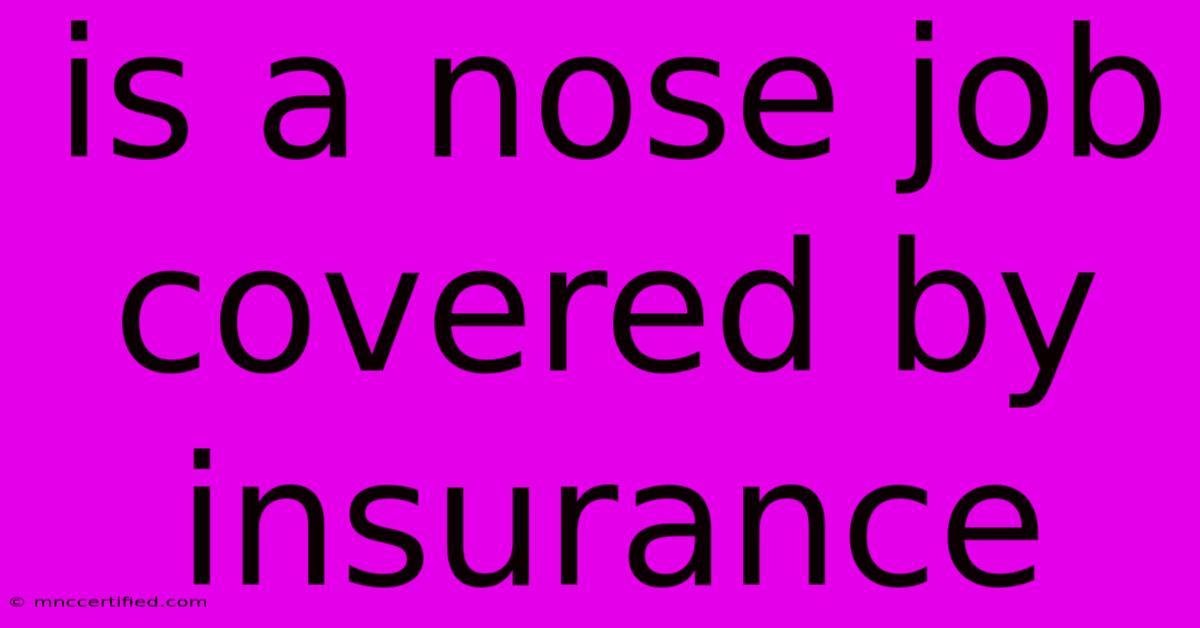Is A Nose Job Covered By Insurance

Table of Contents
Is a Nose Job Covered by Insurance? A Comprehensive Guide
Rhinoplasty, commonly known as a nose job, is a popular cosmetic procedure. But the question many people ask is: is a nose job covered by insurance? The short answer is usually no, unless the procedure is medically necessary. This article will delve into the specifics, helping you understand when you might be able to get coverage and what steps to take.
When Insurance Might Cover Rhinoplasty
While purely cosmetic nose jobs are rarely covered, insurance companies may consider coverage in specific circumstances. These typically involve situations where the surgery addresses a medical necessity, such as:
-
Breathing Problems: If your nose job corrects a deviated septum (a crooked nasal wall) that causes breathing difficulties, insurance is more likely to cover the procedure. This is because a deviated septum can lead to sleep apnea, chronic sinus infections, and other respiratory problems. Your doctor will need to provide comprehensive documentation demonstrating the impact on your respiratory health.
-
Trauma-Related Issues: If your nose was broken or damaged in an accident, and the rhinoplasty is necessary to repair the structural damage, insurance might cover the cost. You'll need thorough medical records documenting the injury and the need for surgery.
-
Congenital Defects: Birth defects affecting the nasal structure can sometimes qualify for insurance coverage. This requires detailed documentation from your physician outlining the nature and severity of the defect.
What Makes a Nose Job Medically Necessary?
The key to securing insurance coverage for rhinoplasty lies in proving medical necessity. This requires strong medical documentation from your physician detailing:
-
Diagnosis: A clear diagnosis of the medical condition necessitating surgery. This should go beyond a simple statement and include specifics about your symptoms, their impact on your daily life, and how the surgery will improve them.
-
Treatment Plan: A detailed treatment plan that explains why rhinoplasty is the necessary and most effective treatment. Alternatives and why they are unsuitable should also be documented.
-
Expected Outcomes: A clear explanation of the expected positive outcomes of the surgery concerning your medical condition.
-
Supporting Evidence: Medical records, imaging (like X-rays or CT scans), and other diagnostic tests should support the diagnosis and the need for surgery.
What to Do Before Your Procedure
If you're considering rhinoplasty and hoping for insurance coverage, take these crucial steps:
-
Consult with your doctor: Discuss your goals and concerns with your surgeon. They can assess whether your case meets the criteria for medical necessity.
-
Obtain pre-authorization: Before scheduling the procedure, contact your insurance provider and obtain pre-authorization. This involves submitting detailed medical documentation to your insurer for review. This step is crucial; undergoing the surgery without pre-authorization significantly reduces your chances of reimbursement.
-
Understand your policy: Carefully review your insurance policy to understand what is and isn't covered. Pay close attention to exclusions and limitations.
-
Keep detailed records: Maintain meticulous records of all communications with your doctor and your insurance company.
The Bottom Line: Proving Medical Necessity
While many people seek rhinoplasty for cosmetic reasons, insurance coverage hinges on proving medical necessity. The process requires thorough documentation and a strong case built by your doctor. Don't rely solely on your surgeon's assessment; actively participate in the pre-authorization process and be prepared to advocate for yourself. Understanding your insurance policy and the specifics of medically necessary rhinoplasty will significantly improve your chances of getting the procedure covered. Remember, transparency and thorough documentation are key.

Thank you for visiting our website wich cover about Is A Nose Job Covered By Insurance. We hope the information provided has been useful to you. Feel free to contact us if you have any questions or need further assistance. See you next time and dont miss to bookmark.
Featured Posts
-
Expanded F1 Grid Closer With Gm
Nov 23, 2024
-
Katt Williams New Studio Alabama Address
Nov 23, 2024
-
Hornets Odac Debut Vs W And L
Nov 23, 2024
-
How To Use Shiba Inu Calculator
Nov 23, 2024
-
Bogdanovich Chers Asshole Comment On Mask
Nov 23, 2024